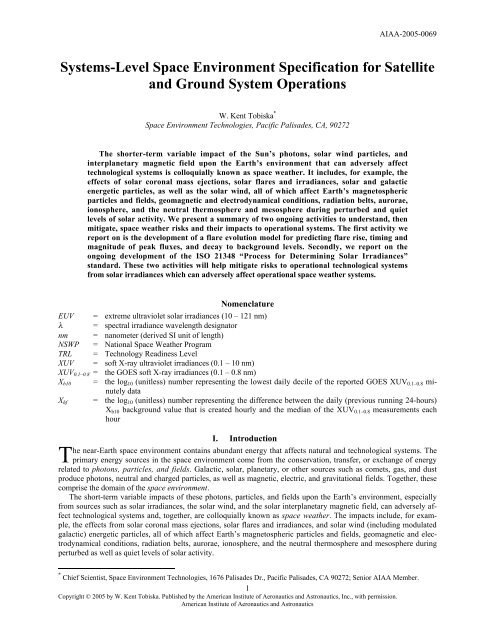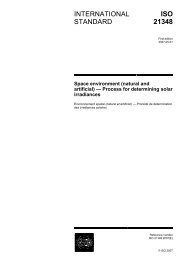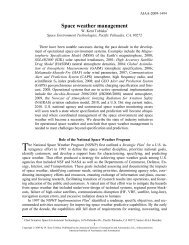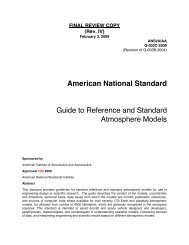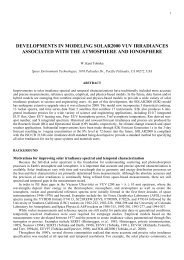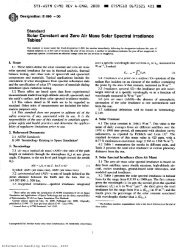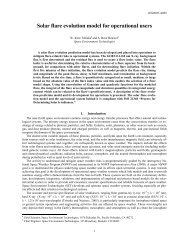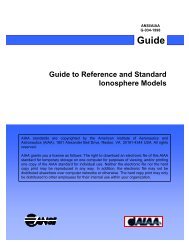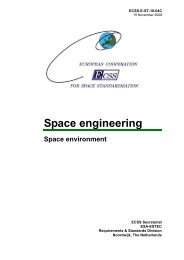Systems-Level Space Environment Specification for Satellite and ...
Systems-Level Space Environment Specification for Satellite and ...
Systems-Level Space Environment Specification for Satellite and ...
Create successful ePaper yourself
Turn your PDF publications into a flip-book with our unique Google optimized e-Paper software.
AIAA-2005-0069<br />
<strong>Systems</strong>-<strong>Level</strong> <strong>Space</strong> <strong>Environment</strong> <strong>Specification</strong> <strong>for</strong> <strong>Satellite</strong><br />
<strong>and</strong> Ground System Operations<br />
W. Kent Tobiska *<br />
<strong>Space</strong> <strong>Environment</strong> Technologies, Pacific Palisades, CA, 90272<br />
The shorter-term variable impact of the Sun’s photons, solar wind particles, <strong>and</strong><br />
interplanetary magnetic field upon the Earth’s environment that can adversely affect<br />
technological systems is colloquially known as space weather. It includes, <strong>for</strong> example, the<br />
effects of solar coronal mass ejections, solar flares <strong>and</strong> irradiances, solar <strong>and</strong> galactic<br />
energetic particles, as well as the solar wind, all of which affect Earth’s magnetospheric<br />
particles <strong>and</strong> fields, geomagnetic <strong>and</strong> electrodynamical conditions, radiation belts, aurorae,<br />
ionosphere, <strong>and</strong> the neutral thermosphere <strong>and</strong> mesosphere during perturbed <strong>and</strong> quiet<br />
levels of solar activity. We present a summary of two ongoing activities to underst<strong>and</strong>, then<br />
mitigate, space weather risks <strong>and</strong> their impacts to operational systems. The first activity we<br />
report on is the development of a flare evolution model <strong>for</strong> predicting flare rise, timing <strong>and</strong><br />
magnitude of peak fluxes, <strong>and</strong> decay to background levels. Secondly, we report on the<br />
ongoing development of the ISO 21348 “Process <strong>for</strong> Determining Solar Irradiances”<br />
st<strong>and</strong>ard. These two activities will help mitigate risks to operational technological systems<br />
from solar irradiances which can adversely affect operational space weather systems.<br />
Nomenclature<br />
EUV = extreme ultraviolet solar irradiances (10 – 121 nm)<br />
λ = spectral irradiance wavelength designator<br />
nm = nanometer (derived SI unit of length)<br />
NSWP = National <strong>Space</strong> Weather Program<br />
TRL = Technology Readiness <strong>Level</strong><br />
XUV = soft X-ray ultraviolet irradiances (0.1 – 10 nm)<br />
XUV 0.1–0.8 = the GOES soft X-ray irradiances (0.1 – 0.8 nm)<br />
X b10 = the log 10 (unitless) number representing the lowest daily decile of the reported GOES XUV 0.1–0.8 minutely<br />
data<br />
X hf = the log 10 (unitless) number representing the difference between the daily (previous running 24-hours)<br />
X b10 background value that is created hourly <strong>and</strong> the median of the XUV 0.1–0.8 measurements each<br />
hour<br />
T<br />
I. Introduction<br />
he near-Earth space environment contains abundant energy that affects natural <strong>and</strong> technological systems. The<br />
primary energy sources in the space environment come from the conservation, transfer, or exchange of energy<br />
related to photons, particles, <strong>and</strong> fields. Galactic, solar, planetary, or other sources such as comets, gas, <strong>and</strong> dust<br />
produce photons, neutral <strong>and</strong> charged particles, as well as magnetic, electric, <strong>and</strong> gravitational fields. Together, these<br />
comprise the domain of the space environment.<br />
The short-term variable impacts of these photons, particles, <strong>and</strong> fields upon the Earth’s environment, especially<br />
from sources such as solar irradiances, the solar wind, <strong>and</strong> the solar interplanetary magnetic field, can adversely affect<br />
technological systems <strong>and</strong>, together, are colloquially known as space weather. The impacts include, <strong>for</strong> example,<br />
the effects from solar coronal mass ejections, solar flares <strong>and</strong> irradiances, <strong>and</strong> solar wind (including modulated<br />
galactic) energetic particles, all of which affect Earth’s magnetospheric particles <strong>and</strong> fields, geomagnetic <strong>and</strong> electrodynamical<br />
conditions, radiation belts, aurorae, ionosphere, <strong>and</strong> the neutral thermosphere <strong>and</strong> mesosphere during<br />
perturbed as well as quiet levels of solar activity.<br />
* Chief Scientist, <strong>Space</strong> <strong>Environment</strong> Technologies, 1676 Palisades Dr., Pacific Palisades, CA 90272; Senior AIAA Member.<br />
1<br />
Copyright © 2005 by W. Kent Tobiska. Published by the American Institute of Aeronautics <strong>and</strong> Astronautics, Inc., with permission.<br />
American Institute of Aeronautics <strong>and</strong> Astronautics
AIAA-2005-0069<br />
The U.S. activity to underst<strong>and</strong>, then mitigate, space weather risks is programmatically directed by the interagency<br />
National <strong>Space</strong> Weather Program (NSWP) <strong>and</strong> summarized in its NSWP Implementation Plan 1 . That document<br />
describes a goal to improve our underst<strong>and</strong>ing of the physics underlying space weather <strong>and</strong> its effects upon<br />
terrestrial systems. A major step toward achievement of that goal is being demonstrated with the development of<br />
operational space weather systems which link models <strong>and</strong> data to provide a seamless energy-effect characterization<br />
from the Sun to the Earth. As guidance to operational space weather projects, the NSWP envisions the evolutionary<br />
definition, development, integration, validation,<br />
<strong>and</strong> transition-to-operations of empirical <strong>and</strong><br />
physics-based models of the solar-terrestrial system.<br />
An end result of this process is the selfconsistent,<br />
accurate specification <strong>and</strong> reliable<br />
<strong>for</strong>ecast of space weather.<br />
The accurate <strong>and</strong> precise specification of solar<br />
irradiances, ranging from gamma-ray (10 -5 ≤ λ <<br />
10 -3 nm) to radio (10 5 ≤ λ < 10 11 nm) wavelengths<br />
2 , is particularly important <strong>for</strong> space or<br />
ground system operations <strong>and</strong> engineering activities<br />
that are affected by space weather. Wavelengths,<br />
especially those shortward of 200 nm, not<br />
only deposit their energy in the Earth’s thermosphere,<br />
mesosphere, <strong>and</strong> stratosphere as well as<br />
create the ionosphere but also provide energy<br />
affecting spacecraft components <strong>and</strong> surfaces<br />
through radiation, surface charging, surface degradation,<br />
<strong>and</strong> thermal balance effects (Fig. 1).<br />
Figure 1. Photon effects in the space environment. The<br />
solar spectrum <strong>and</strong> associated wavelength regions that affect<br />
aeronomy, GPS/HF systems, <strong>and</strong> space systems users.<br />
Operational solar irradiance products with sufficient accuracy <strong>and</strong> precision <strong>for</strong> contemporary applications have<br />
already been transferred to space weather operational users <strong>and</strong> have been previously reported 3,4,5 . In 2004, additional<br />
irradiance specification improvements have been developed including the capability to predict the evolution<br />
of solar flares immediately after their initiation as well as the st<strong>and</strong>ardization of irradiance products. Both improvements<br />
help mitigate solar irradiance risks to technological systems <strong>and</strong> these developments are reported in this<br />
paper. The main operational users motivating activities include those who require improved comm<strong>and</strong> <strong>and</strong> control<br />
capabilities <strong>and</strong> need updated ionospheric parameters including total electron content (TEC) <strong>for</strong> GPS signal reduced<br />
uncertainty <strong>and</strong> F2 region critical frequency, f 0 f2, <strong>for</strong> HF propagation knowledge.<br />
II.<br />
Mitigation of <strong>Space</strong> Weather Effects<br />
A. Solar Flare Evolution Prediction<br />
In this report, we demonstrate solar flare evolution prediction at the TRL 3 level (modeled proof-of-concept<br />
demonstration) <strong>and</strong> in 2005 we will move the algorithm to TRL 9 (system operations at <strong>Space</strong> <strong>Environment</strong> Technologies<br />
(SET)) within the SOLAR2000 model 6,7 . Flare evolution prediction does not estimate when a flare will<br />
occur but is, instead, the prediction of a flare’s morphology once it has begun. Flare prediction, based on a physics<br />
underst<strong>and</strong>ing of helicity <strong>and</strong> magnetic flux tube energy transfer, as well as flare spectral energy distribution are<br />
both broad science topics of great contemporary interest. Our work complements the <strong>for</strong>mer activity <strong>and</strong> is the precursor<br />
step required to accurately define the latter.<br />
Solar flare evolution prediction characterizes the initiation, timing of peak flux, magnitude of peak flux, <strong>and</strong> decay<br />
from peak flux to background levels <strong>for</strong> medium <strong>and</strong> large flares, i.e., those that are geoeffective. There is a two<br />
step process <strong>for</strong> characterizing flare evolution. First, a flare must be distinguished from the background irradiance<br />
component; a flare is short-lived (minutes to hours) <strong>and</strong> is determined by the energy content (helicity) <strong>and</strong> magnetic<br />
flux tube characteristics of localized solar magnetic fields. The transport of charged particles along flux tubes <strong>and</strong><br />
their energy transfer processes produce irradiances across the spectrum. The background irradiances are long-lived<br />
<strong>and</strong> derive from different physical phenomena, especially a geometrical view relative to the central solar meridian as<br />
well as the long-term growth <strong>and</strong> decay of active regions that are surface manifestations of solar magnetic field<br />
evolution. Separating these two components is crucial <strong>for</strong> underst<strong>and</strong>ing how flares evolve beyond the background<br />
<strong>and</strong> we have created an X-ray background index, X b10 , <strong>and</strong> an X-ray flare index, X hf , to define these two components.<br />
2<br />
Copyright © 2005 by W. Kent Tobiska. Published by the American Institute of Aeronautics <strong>and</strong> Astronautics, Inc., with permission.<br />
American Institute of Aeronautics <strong>and</strong> Astronautics
AIAA-2005-0069<br />
The first, X b10 , is the log 10 (unitless) number representing the lowest daily decile of the reported GOES<br />
XUV 0.1–0.8 minutely data (eq. 1). One-hour of minutely XUV 0.1–0.8 data is collected <strong>and</strong> the value of the lowest decile<br />
is saved. Over the course of a previous 24-hour period, the lowest of the twenty-four decile values is selected as the<br />
X b10 background value. The resulting X b10 index provides the best removal of flare effects we have found. Physically,<br />
it represents the T ≈ 10 6 K coronal emission that gradually evolves on active region time scales. It is different<br />
from the solar 10.7-cm radio flux (F 10.7 index) which is created in the cooler T ≈ 10 4 K transition region.<br />
X b10 = 100 log 10 (XUV 0.1–0.8 × 10 10 ) (1)<br />
The second index, X hf , is the log 10 (unitless) number representing the difference between the daily (previous running<br />
24-hours) X b10 background value that is created hourly <strong>and</strong> the median of the XUV 0.1–0.8 measurements each<br />
hour. This index provides a good estimate of T ≈ 10 6<br />
K or T ≈ 10 7 K hot coronal flare activity. Figure 2,<br />
top panel, shows the XUV 0.1–0.8 measurements each<br />
hour <strong>for</strong> the two-month period of October 1 – November<br />
30, 2003 during major flares. NOAA <strong>Space</strong><br />
<strong>Environment</strong> Center (SEC) flare classes are listed on<br />
the right-h<strong>and</strong> side of the panel. The figure 2 bottom<br />
panel shows X b10 <strong>and</strong> X hf separated from each other.<br />
The flare initiation, timing of peak flux, magnitude<br />
of peak flux, <strong>and</strong> decay from peak flux to<br />
Figure 2. X-ray background <strong>and</strong> X-ray flares. The GOES<br />
0.1–0.8 nm X-ray data is shown in the top panel as reported<br />
by NOAA/SEC while the bottom panel demonstrates the X b10<br />
<strong>and</strong> X hf separated from one another during the Oct-Nov 2003<br />
solar storm period.<br />
Figure 3. dX hf /dt vs flare magnitude. The (inverse) correlation<br />
between flare rate of change, dX hf /dt, <strong>and</strong> flare magnitude<br />
is shown as the straight line with a correlation coefficient of<br />
–0.78; large flares that are compared with the model are<br />
shown as large circles <strong>and</strong> numbered.<br />
background levels <strong>for</strong> medium <strong>and</strong> large flares has<br />
been modeled using a correlation between the time<br />
rate of change of the flare, dX hf /dt, <strong>and</strong> its magnitude.<br />
The variable, dX hf /dt, is obtained after separating<br />
the X b10 background so that the actual flare<br />
start time, rise phase, <strong>and</strong> decay shape can be determined.<br />
Figure 3 shows the correlation of dX hf /dt<br />
versus flare magnitude, figure 4 demonstrates the<br />
empirical flare model which uses a Gaussian combined<br />
with a quadratic function, figure 5 compares<br />
the flare model with two of the largest flares during<br />
the November 2003 storm period, <strong>and</strong> equations 2,<br />
3, <strong>and</strong> 4 describe the flare model using only the<br />
dX hf /dt <strong>and</strong> time, t, variables as input.<br />
In 2005, at the TRL 9 level, SET will produce<br />
previous-hour X b10 <strong>and</strong> X hf indices from the GOES<br />
XUV 0.1–0.8 measurements every 5 minutes in order to<br />
generate dX hf /dt <strong>and</strong> the running 6-hour prediction<br />
of X hf at that cadence. The resulting flare peak magnitude,<br />
timing, <strong>and</strong> duration will be combined with the running background level to then generate other irradiances<br />
<strong>and</strong> proxies <strong>for</strong> use in operational applications 6,7 .<br />
X hf<br />
(t) = F(dX hf<br />
dt){−129.289e −z 2 0.5 +150.746 − 50.9065t + 4.6531t 2 }<br />
(2)<br />
€<br />
€<br />
€<br />
z = t 0.0964943<br />
F(dX hf<br />
dt) = 0.5{0.897508 − 0.0195723(dX hf<br />
dt)}<br />
B. <strong>Space</strong> <strong>Environment</strong> St<strong>and</strong>ardization<br />
The International St<strong>and</strong>ards Organization Technical Committee 20, Aircraft <strong>and</strong> space vehicles, Subcommittee<br />
14, <strong>Space</strong> systems <strong>and</strong> operations, Working Group 4, <strong>Space</strong> <strong>Environment</strong> – Natural <strong>and</strong> Artificial has developed a<br />
Draft International St<strong>and</strong>ard “<strong>Space</strong> environment (natural <strong>and</strong> artificial) – Process <strong>for</strong> determining solar irradiances”<br />
(3)<br />
(4)<br />
3<br />
Copyright © 2005 by W. Kent Tobiska. Published by the American Institute of Aeronautics <strong>and</strong> Astronautics, Inc., with permission.<br />
American Institute of Aeronautics <strong>and</strong> Astronautics
AIAA-2005-0069<br />
(ISO 21348) 2 . The draft st<strong>and</strong>ard specifies the<br />
process <strong>for</strong> determining all representations of solar<br />
irradiances including measurements, reference<br />
spectra, empirical models, theoretical models, <strong>and</strong><br />
solar irradiance proxies. The purpose of the st<strong>and</strong>ard<br />
is to provide common methods <strong>and</strong> <strong>for</strong>mats<br />
<strong>for</strong> characterizing all solar irradiances <strong>for</strong> use by<br />
space systems <strong>and</strong> materials users. The space<br />
physics scientific community <strong>and</strong> other engineering<br />
disciplines will also be potential users of this<br />
st<strong>and</strong>ard.<br />
ISO 21348 does not specify one measurement<br />
set, one reference spectrum, one solar model, or<br />
one solar irradiance proxy as a single st<strong>and</strong>ard.<br />
Instead, in order to encourage continual improvements<br />
in solar irradiance products, ISO<br />
21348 is written as a process-based st<strong>and</strong>ard <strong>for</strong><br />
determining solar irradiances. In other words, in<br />
the course of developing a solar irradiance product,<br />
a reporting process is followed in order to<br />
certify compliance with the st<strong>and</strong>ard <strong>and</strong> this ensures<br />
that a robustness of st<strong>and</strong>ardization is<br />
achieved. The process used <strong>for</strong> determining solar<br />
irradiances reported herein is compliant with ISO<br />
International St<strong>and</strong>ard 21348: <strong>Space</strong> <strong>Environment</strong><br />
(Natural <strong>and</strong> Artificial) – Process <strong>for</strong> determining<br />
solar irradiances (type 5 solar proxy <strong>for</strong> XUV <strong>and</strong><br />
EUV irradiances).<br />
III.<br />
Conclusion<br />
We present a model of flare evolution <strong>for</strong> use<br />
by space <strong>and</strong> ground system operational users<br />
interested in characterizing solar irradiance energy<br />
input by time <strong>and</strong> magnitude <strong>for</strong> ionospheric<br />
<strong>and</strong> thermospheric applications. The model accurately<br />
detects the initiation of flares <strong>and</strong> predicts<br />
the peak flux timing <strong>and</strong> magnitude within 20%.<br />
Figure 4.Flare evolution model. The 1-hour flare data<br />
(black dots) are compared with several modeled flares (numbers<br />
are referenced to figure 3).<br />
Figure 5. Flare evolution model compared with data. The<br />
1-hour flare data (black dots) <strong>and</strong> the 1-minute (gray dots) are<br />
compared the flare model <strong>for</strong> November 2–4, 2003 (integer<br />
numbers are referenced to figure 3 <strong>and</strong> real numbers are flare<br />
model irradiance values); magnitude uncertainties are ~20%.<br />
Acknowledgments<br />
Support <strong>for</strong> this work has been provided by the NASA TIMED contract NAG5-11408 <strong>and</strong> by the NASA Living<br />
With a Star contracts NASW-02030 (GSFC) <strong>and</strong> 4200000428 (MSFC).<br />
References<br />
1 National <strong>Space</strong> Weather Program Implementation Plan, 2nd Edition, FCM-P31-2000, Washington, July 2000.<br />
2 Tobiska, W.K. <strong>and</strong> A.A. Nusinov, Status of ISO draft international st<strong>and</strong>ard <strong>for</strong> determining solar irradiances (DIS 21348),<br />
J. Adv. <strong>Space</strong> Research, in press, 2005.<br />
3 Tobiska, W.K., E10.7 use <strong>for</strong> global atmospheric density <strong>for</strong>ecasting in 2001, AIAA 2002-4892, AIAA Aerospace Sciences<br />
Meeting, Reno, NV, January, 2002.<br />
4 Tobiska, W.K., Forecast E10.7 <strong>for</strong> Improved LEO <strong>Satellite</strong> Operations, J. <strong>Space</strong>craft Rock., 40 (3), 405-410, 2003.<br />
5 Tobiska, W.K., Forecasting of space environment parameters <strong>for</strong> satellite <strong>and</strong> ground system operations, AIAA 2003-1224,<br />
AIAA Aerospace Sciences Meeting, Reno, NV, January, 2003.<br />
6 Tobiska, W.K., SOLAR2000 irradiances <strong>for</strong> climate change research, aeronomy, <strong>and</strong> space system engineering, Adv. <strong>Space</strong><br />
Research, 34, 1736-1746, 2004.<br />
7 Tobiska, W.K. <strong>and</strong> S.D. Bouwer, New Developments in SOLAR2000 <strong>for</strong> <strong>Space</strong> Research <strong>and</strong> Operations, Adv. <strong>Space</strong> Research,<br />
in press, 2005.<br />
4<br />
Copyright © 2005 by W. Kent Tobiska. Published by the American Institute of Aeronautics <strong>and</strong> Astronautics, Inc., with permission.<br />
American Institute of Aeronautics <strong>and</strong> Astronautics


